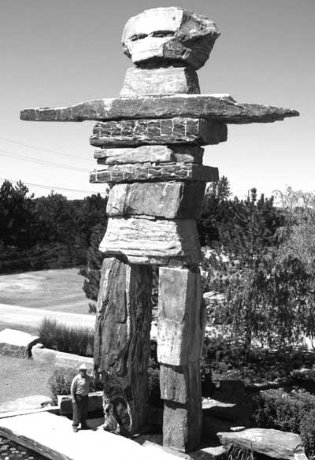Most Canadians spell it inukshuk. The government of Nunavut says it’s inuksuk. No matter how you spell it, Joe Melo owns the largest one in the world and the Guinness Book of World Records is ready to honour that achievement.
World Record Build
Most Canadians spell it inukshuk. The government of Nunavut says it’s inuksuk. No matter how you spell it, Joe Melo owns the largest one in the world and the Guinness Book of World Records is ready to honour that achievement.
At 11.9 metres high, Melo’s inuksuk beats the nearest competition, the 2010 Olympic mascot, by almost three metres. Built from 11 pieces of solid granite, the giant statue weighs 82 tonnes. The arms alone—made of a single slab of granite—are a half-metre thick and span more than 8 metres across.
The statue was assembled by crane and is held together by gravity alone, with only the inuksuk’s feet imbedded in solid concrete.
Melo, owner of Allstone Quarry Products near Shomberg, extracted the granite from his quarry in Big Wood Township located about 40 minutes south of Sudbury.
The statue was officially submitted to the Guinness organization yesterday as a certified structural engineer, a certified surveyor and other witnesses made a full report on the monument’s vital statistics.
Melo, who supplies some of the biggest chunks of rock in the province, says he never intended to beat the world’s record. He built the structure about five years ago and says he wasn’t aware that the inuksuk was the world’s tallest until several marketing companies brought the fact to his attention.
“We didn’t want to commercialize it,” says Melo. “We built it to create an awareness of the beauty of natural stone, promote northern Ontario granite and to honour Canada’s aboriginal people who used these statues as a navigation aid along northern waterways.”
Melo says that the granite used in the statue—granite gneiss—has a high micah content, which imparts flexibility to the stone, allowing him to mine large slabs that won’t crack when extracted. “We supplied a 28-foot (8.5-metre) slab to the University of Waterloo,” says Melo. “That slab can be flexed by up to four inches (10 centimetres) either way.”
The largest part of Melo’s business involves supplying monument-sized chunks of granite to housing developers who want to mark a new development with something distinctive. Melo supplies the stone and engraves the subdivision name into the rock face before delivering it.
The inuksuk also has a name, but it isn’t engraved on the statue. The nickname “Little Joe” was chosen as a gag by Melo’s employees. Melo stands a little over 173 centimetres.
“One of our engineers likes to say that the inuksuk stands about ‘seven Joes high,’” says Melo.











Recent Comments
comments for this post are closed